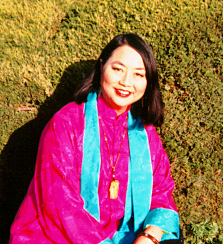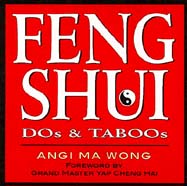Unless you have been living in a cave in the past year, the subject of feng shui, literally,
"wind-water" in Chinese, the ancient environmental system of placement, has been inescapable!
In electronic and print media, from coast to coast, continent to continent, and everywhere in between,
there's no doubt that nationwide and globally, people are becoming more aware, acquainted, enamored,
and yes, confused, about feng shui. Books on the subject are being churned out at a furious pace,
written by masters and novices alike, making this 3,500-year-old Chinese tradition the hottest design
trend and conversation topic going around.
As an intercultural and feng shui consultant and corporate facilitator to over 90 major residential
and commercial developers as well as Crustacean Restaurant in Beverly Hills, Universal Studios UEX in
Beijing, COTY International, The Limited, Paul Ank Productions, AT& T, Bank of America and Ford, among
others, I have been deeply involved in educating clients, audiences and readers alike about feng shui for
over fifteen years. During the real estate depression in California of the early 1990s, builders
discovered that new home buyers were Asians, and that this centuries-old practice needed their attention.
Because "bridging cultures for better business between Asians and non-Asians" through consulting,
training, speaking, writing, and publishing has been and is my business, my timing couldn't have been better
to be a vanguard on the subject.
Having being raised in a Chinese household, albeit in New Zealand, Taiwan, Hong Kong, New York,
and finally in Washington, D.C., how could I not have heard about this thing called feng shui?
It was one of the mysterious topics that were made references to, along with the warnings not to
eat fried foods because they were "yeet hay," literally "hot energy." I think
that most people, myself included, don't know what they know, until someone asks about it, much like
having good manners. You may learn how to dance from Dad at home, but you still have to go to
Cotillion to get fine-tune your skills! It wasn't until my developer clients asked me to teach
their sales people about feng shui, that I realized how much about it I had absorbed in my
upbringing by osmosis.
The Chinese invented the compass in the fourth century B.C. It is well documented that by the
third century, this ingenious device was being used to aid in the proper placement of grave and
home sites. Later the compass' value to seafarers and navigation was developed. The Chinese believe
that we are all connected by cosmic, universal energy called chi to our ancestors, and to find the
best optimum final resting place for them was to ensure health, harmony, and prosperity for us, their
descendents.
Feng shui is one of the five components of our life or destiny. These are fate, luck, feng shui,
charity, and education. Each of these is arbitrarily assigned a percentage of influence in molding
our lives: 70%, 15%, 5%, 5%, and 5%, respectively. Fate is who and what you are - your gifts from
heaven at birth. Luck is what happens to you after you are born. I contend that although fate
and luck influence our lives the most, the latter three components are the proactive things we can
do to change its course.
My favorite analogy is that life is a journey and you start from one place and end up somewhere else,
experiencing a range of adventures, ups and downs, people, weather, and everything, well, life, along
the way. Your feng shui, charitable and philanthropic, and educational choices are the proactive
decisions that determine as well change your mode of transportation along the way.
While looking at and evaluating land forms, water ways and geography gave birth to the Form School
of feng shui in southern China, it was the very absence of those geographical and geological features,
and the relative flat topography of the north that necessitated the development of the Compass School.
In the United States, a third school has gained popularity, the Black Sect Tantric Tibetan School, but
as a speaker at the International Feng Shui Conference in London earlier this year in May, I discovered
that the Compass School dominates in the rest of world. There are as many forms of feng shui as there
are schools and practitioners, but there are some basic fundamentals shared by all.
The most popular forms of feng shui at this time are the Compass School and the Black (Hat) Sect
Tantric Tibetan Buddhist School. Compass school is the traditional, classical feng shui practice which
uses either a Chinese (luo pan) or Western-style compass to determine the eight compass directions in
your rooms, office, or home. Because those directions govern various aspects of your life, you
would then place the corresponding colors, animal symbols, numbers, and elements in those the areas
that you wish to activate. In the BSTB school, you would totally disregard compass directions, stand
at and use the entrance of the room, house, or office as your main reference point, and this spot
would change from room to room, depending on the location of its entrance. Then you would place
objects and other enhancements according to the different aspirations and accomplishments of
your life that you want to activate.
Whichever school of feng shui you choose to practice, but particularly in the Compass School, the
three major concepts are the same: flow of energy, the balance of yin and yang, and the interaction
of the five elements. You will also recognize these as those components that comprise the foundation
of traditional Chinese medicine (TCM), tai chi, chi gong, accupuncture, accupressure,
herbal cures, and other Chinese medical practices.
In nature, we only find perfectly straight lines in very short segments, as in the canes of sugar
and bamboo. Even the tallest redwoods and pines have irregularities, and it is a natural law that
energy flows in wavy lines like the breezes, mountain ranges, and streams. This undulating flow is
beneficial and natural. In the land, chi moves in dragon lines along the topography; in people, its
paths are channels called meridians.
When we see a river destroying everything in its path through the center of a town, we notice that
the water is usually following something man-made, such a road. Freeways, tunnels, bridges,
buildings, corners of building, lampposts, etc. all have straight edges which are considered conduits
of negative energy called sha ch'i or "killing energy." In feng shui, such are to
be avoided.
Secondly, the duality of the universe and the world around us is expressed in the tai chi, a
circle created by a light and a dark droplet, positioned end to end. Yin is the female, soft,
passive, nurturing, fluid, even numbers and the right side. Yang is male, bright, hard, active,
aggressive, odd numbers and the left side. The two comprise a whole, and yet there is an element
of each in the other. Dividing the two halves is a fluid S line which moves, according to the\
balance in the universe, nature, the environment surrounding us, and in us.
Sometimes we have too much yang, and other times, we have too much yin. It is up to us to personally
find and maintain the balance between the two in our physical, mental, emotional, spiritual, sexual,
and intellectual selves. By achieving this balance is to experience being grounded or centered -
much like a rock that is pounded by the elements and still remains unyielding. Notice that in each
half, there is the presence of its complement, in the form of a dot. While in Chinese philosophy,
this has been accepted knowledge for several thousand years, the acknowledgement that every male has
a feminine aspect, and every female, has a male, is new to the Western mind and medicine.
Then at last, are the five elements: fire, earth, metal, water, and wood. Each one of them relates
to the other in two different ways. The first is in a generative or creative manner that gives
strength and power to all. The second relationship is one that shows how each can be overcome or
destroyed. Knowing the two cycles is critical in feng shui and placement for misinformation or
lack of knowledge can bring on the opposite effect of what you are trying to achieve.
The creative/generative/birth cycle is as follows: water nourishes wood, wood makes fire, fire
creates earth (as in volanoes), earth creates metal, metal creates water. The destructive cycle
contends that water puts out fire, fire melts metal, metal cuts wood, wood displaces earth, earth
dams water.
Whichever form of feng shui you choose to practice, be consistent and practice one school at a time.
If it does not give you the results that you seek, feel free to try the another. The guidelines
remain basically the same: put the right objects in the right place to be in harmony and balance
with yourself, nature, and the universe. Meanwhile, you will also be activating the various areas
of your life that you wish to improve: harmony, health, love, romance, marriage, children, business,
career, creativity, self-development, wealth, and fame, fortune, and aspirations.
While there are no hard and fast rules in feng shui, there are many general guidelines. Here are
just a few basics:
-
Choose a classic feng shui location for your home, business, temple, or
grave site, that looks like an armchair with a high hill for a back, two smaller hills in
front, and a wide view, preferably of water, in front.
-
You should always walk up to your site rather than down to it (below grade.)
-
Front and back doors in your home or business should not line up as chi will just
rush through without bringing its benefits to you and your family.
-
Your building should not be located at the end of a T intersection created by two
intersecting streets, nor should it be in the cradle of a Y, e.g., one street that becomes
two streets.
-
The footprint of your building should be basically square or rectangular as these
represent balance, and awkward angles should be avoided.
-
If there is a water element such as a river or stream on your property, it should be
slow-moving and located in front, symbolizing wealth coming towards you, rather than
in the back, meaning that wealth is flowing away.
-
The area in front and behind the main entrance of your home or office should be
unobstructed to facilitate a good flow of chi.
-
The main bedroom should be located past the horizontal center line of the house for
strength, support, and protection.
-
All doors and windows should open freely, whether you use them or not.
-
Avoid properties that are in close proximity to power towers, transformers, schools,
churches, government and other institutional buildings, hospitals, burial grounds,
cemeteries, and mortuaries.
-
Do not have a bathroom or toilet next to, above on the second floor, or past the main
entrance to your home or business as these portend calamity to the family.
-
A structure created with good architectural design and regard to ecology, topography,
and conservation, with a clean traffic flow and good air circulation is also reflecting
the principles of good feng shui.
Much, if not most, of what you will do is using good common sense, sound architectural design, and
intuition, for feng shui is based on respecting the gifts of life and the world around us.
Geography, ecology, meteorology, astronomy, interior design, ancient Chinese philosophies such as
Taoism, Buddhism, and folk beliefs that have survived thousands of years are all a part of the mix.
These are the keys to creating good feng shui as you tap into the tao, or path or flow of the
universe and its rhythms for a more holistic, natural and simple way of life.










